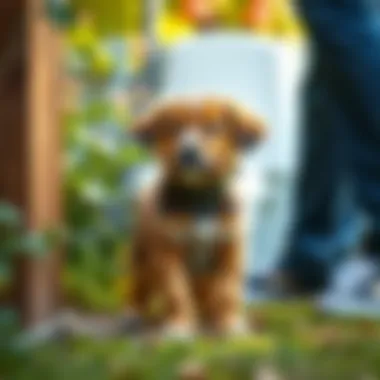Optimal Puppy Bathroom Schedule for a Healthy Routine


Intro
When you bring a new puppy into your home, one of the most fundamental aspects of pet ownership is understanding their potty needs. This topic is not just about convenience; it plays a significant role in establishing a routine that supports your puppy's overall health and well-being. Puppies, like human babies, can’t hold their bladders for long periods, and improper handling can lead to accidents indoors, which can be frustrating for both the owner and the dog. Knowing how often to take your puppy outside requires consideration of several key factors, such as age, breed, diet, and even their current health status.
Establishing a regular potty schedule is crucial. It helps to avoid stressful situations while training your new furry friend. The aim of this guide is not just to inform but to empower you with practical knowledge. With the right information, you can create a harmonious living environment and ensure your puppy has a successful start in life. This lays the groundwork for a well-trained companion, one that doesn't just instinctively know where to go, but thrives in the home atmosphere you provide.
Factors Influencing Potty Frequency
A puppy's age is often at the top of the list when it comes to factors influencing how frequently they need to potty. Young puppies, especially those under six months, may need to go out every one to two hours. As they mature, this interval can stretch out, but it can still vary significantly based on their daily routine and other contributing factors, such as dietary habits
Another significant factor is the puppy's breed. Larger breeds tend to have a different level of capacity than smaller ones. For example, a Great Dane might be able to hold its bladder for longer than a Chihuahua. Thus, understanding breed norms can greatly inform your expectations regarding potty training.
Health is also paramount. If your puppy is unwell or has recently undergone a significant change in diet, this can disrupt their usual patterns of elimination. Recognizing any shifts in behavior can help prevent potential health issues before they escalate.
As you begin this journey, keep these factors in mind when creating your puppy’s potty schedule, as they are the backbone of the successful habits you will instill.
Preamble to Puppy Toilet Training
Establishing a solid foundation in puppy toilet training plays a critical role in nurturing a harmonious relationship between pet and owner. Any seasoned dog owner will tell you that getting this routine right can save time, prevent frustrations, and encourage a healthier lifestyle for everyone involved. When done properly, using consistent toilet habits helps puppies learn faster, resulting in fewer mishaps in the home.
One of the primary benefits of upping your game in toilet training is minimizing accidents. Though mishaps are part and parcel of life with a young pup, having a structured routine can reduce how often these occur. This consistency leads not only to an easier transition for your furry friend but also brings peace of mind to the owner, who won’t be constantly on edge about an impending mess.
Moreover, being mindful of your puppy’s behavior patterns sheds light on their needs. Puppies, much like toddlers, have limited control and often cannot hold their bladder for extended periods. Understanding their needs is crucial. This might include being attuned to subtle cues that indicate they need to go out, which brings us to the next aspect of toilet training.
The importance of timing cannot be stressed enough in this process. A well-timed break can prevent many bathroom-related woes. Puppies tend to need frequent breaks, especially after eating, waking from a nap, or playing intensely. Establishing specific times to take your puppy out can greatly assist in recognizing and responding to their needs efficiently.
"A happy puppy is a puppy that knows when and where to go."
Furthermore, each puppy is unique. Factors like age and breed influence how often they need to go out. For example, smaller breeds often have bladders that fill faster than larger breeds. Thus, being equipped with age-related knowledge enhances your puppy toilet training experience.
The journey of potty training can be fraught with ups and downs. However, it is essential to approach it with patience, empathy, and a clear understanding of your puppy’s instincts and habits. By doing so, pet owners create an environment where their little companion can flourish.
Factors Influencing How Often to Take Puppies Out
Understanding how often to take your puppy out for a pee break isn’t just about being kind to your carpets—it's crucial for their overall well-being. This section dives into the various factors that impact this frequency, helping dog owners craft an effective schedule that respects their puppy’s needs. From age to breed, and even health considerations, several elements play a role in determining the best practices for potty breaks.
Age Considerations
As puppies grow, their bladder control improves. Young pups, typically under three months, have limited control and need frequent breaks—often every 30 minutes to an hour. At this tender age, their kidneys aren’t fully developed, leading to smaller amounts of urine but more frequent releases.
It’s vital to remember that their small bladders can lead to accidents. An impatient or oblivious owner might cause frustration, leaving a mess behind. As they reach three to six months, they can usually hold it for up to two hours, but diligence is still key. After six months, most breeds can manage a longer stretch without peeing.
Breed and Size Variations
When considering potty time, breed and size of your puppy can’t be ignored. Small breeds like Chihuahuas or Dachshunds may need more frequent trips outside compared to larger breeds, like Golden Retrievers or Great Danes. This difference comes down to their overall size and the volume they can keep in their bladders.
Also, energy levels and metabolism differ among breeds. Active pups may drink more water and therefore need to urinate more frequently. Using breed-specific guides on potty needs can make a world of difference, permitting tailored approaches that fit your puppy’s unique characteristics.
Health and Dietary Impacts
A puppy’s health status and diet are critical pieces of the potty-training puzzle. Certain medical conditions, like urinary tract infections, can lead to increased urination frequency. A sick puppy might need to go out more often than a healthy one.
Diet also plays a major role in this equation. High-salt foods, for instance, tend to increase thirst and thus lead to more potty breaks. Keeping the puppy’s diet consistent not only aids in training but also produces dependable bathroom habits. Consider monitoring water intake as well; puppies that drink more will need to relieve themselves more often.
Remember: Keeping a close eye on your puppy's habits and behaviors will go a long way to help you establish a reliable routine that caters to their unique needs.
By understanding these factors, new puppy owners can better tailor their approach to potty training. Creating a routine that flexibly accommodates age, breed characteristics, and health can turn what can feel like an overwhelming task into a manageable part of life. Taking a moment for these considerations avoids frustration for both pet and owner while ensuring a harmonious household.


Signs That Indicate It's Time for a Break
Understanding when your puppy needs to relieve itself is crucial for effective toilet training. This section highlights key indicators that suggest your puppy is ready for a break. Recognizing these signs not only minimizes accidents in the home but also fosters a deeper bond of trust between you and your puppy. When puppy owners can read and respond to their pet’s signals, it leads to smoother training and promotes a consistent routine.
Common Behavioral Cues
Puppies communicate primarily through their behavior. Noticing changes in their actions can provide good insight into when they need a bathroom break. Here are some common behaviors to watch for:
- Pacing: If your puppy starts to walk in a tight circle or moves around restlessly, it could mean they're searching for a spot to settle down and relieve themselves.
- Sniffing: Dogs have an amazing sense of smell, and when they sniff around the house or yard more intensely, it might suggest they’re looking for potty spots.
- Whining or Barking: Vocalizations such as whining or barking can be their way of signaling urgency, especially if they are trying to get your attention.
- Scratching at the Door: This is often a pretty clear sign they need to go out. If your pup is pawing at the door or even sitting in front of it, it’s best you respond quickly.
"Understanding your puppy’s behavior is half the battle in successful toilet training. It’s all about learning to listen to them in their own language."
Being attentive to these cues ensures your puppy doesn’t experience unnecessary stress from waiting too long. Each signal must be taken seriously, as a failure to act promptly could result in an accident indoors.
Physical Signs of Urgency
In addition to behavioral cues, physical signs can also indicate when it’s time for a break. Observing your puppy’s body language can effectively inform you about their needs:
- Restlessness or Increased Activity: An active puppy suddenly shifting gears into a more frenetic state might be signaling for a bathroom break.
- Tail Position and Movement: If your pup's tail is tucked or moving erratically, it’s often a clue they are anxious or uncomfortable and may need to relieve themselves.
- Squatting or Looking Back at Their Rear: This is a classic sign they are preparing to do their business. It’s vital to intervene at this moment to avoid indoor accidents.
- Paw Lifting: Many dogs naturally lift a paw when they are about to urinate, especially males. This behavior can apply to females too but may be less pronounced.
Regularly stepping outside with your puppy when you notice these signs can establish a routine and help prevent any bothersome messes. Both the behavioral and physical indicators work hand in hand, and acknowledging them leads to a comprehensive understanding of your puppy’s needs.
Establishing the Right Routine
Establishing a reliable bathroom routine for your puppy is crucial in developing good habits and maintaining their well-being. Having a structured schedule aids in shaping your puppy's understanding of when and where it’s appropriate to relieve themselves. By creating a consistent routine, you help minimize accidents, improve house training, and enhance the overall bond between you and your furry friend.
It's not just beneficial for the puppy; it creates a predictable environment for pet owners, allowing them to manage their own schedules better. Having a set plan encourages responsibility and awareness between both the owner and their puppy. If done right, it nurtures a shared understanding of necessities, leading to a smoother journey in toilet training.
Creating a Schedule
Morning Routine
The morning routine sets the tone for the entire day. When you wake up with your puppy, the first thing to do is take them outside. This serves a dual purpose: it not only helps them relieve themselves after a long night's sleep, but it reinvigorates the bond through interaction. A morning walk also stimulates their senses, preparing them for the day ahead.
One key characteristic of the morning routine is its built-in predictability. It’s a beneficial choice because it hinges on the natural cycle of your day, making it easier to remember. The unique feature here is the immediate response to their needs first thing in the morning, which can lead to fewer accidents indoors throughout the day. However, if you delay this part of the routine, you may see increased anxiety or urgency from your puppy, potentially leading to missteps.
Midday Breaks
Midday breaks play a vital role in filling the gaps created by a busy morning. Taking your puppy out around lunchtime could significantly alleviate any discomfort they feel after several hours. Just like humans, little ones need their periodic nature calls, and a break around midday fits the bill perfectly.
The character of midday breaks centers around the rhythm of the day, providing a necessary pause that can invigorate both the puppy and owner. It’s a beneficial choice because it reduces the likelihood of accidents in the house, especially for younger or newly adopted puppies. One drawback, however, can be the conflict with work schedules that might not allow flexibility during this time, which can cause inconsistency in their routine.
Evening Rituals
Evening rituals offer a time to reflect and unwind after a long day. Taking your puppy out in the evening doesn't just serve the purpose of relieving themselves; it's a chance for evening bonding moments, perhaps over a game of fetch or a leisurely stroll. This period helps them to settle down for the night; it’s crucial for tiring them out before bed.
A key aspect of evening rituals is the opportunity for socialization with other dogs or pet owners, which can be extremely vital for a puppy’s development. Being a popular choice, it lays a foundation for a consistent routine as the day draws to a close. However, if the evening trip is skipped or cut short, it can lead to unnecessary accidents overnight, disrupting not only the puppy's routine but the owner's rest as well.
Incorporating Rewards
Positive reinforcement brings something special into puppy toilet training routines. By acknowledging and rewarding your pup for doing their business outside, you establish a connection between what is expected and the delightful feeling of success. It can be as simple as a treat, a verbal confirmation, or a quick scratch behind the ears. This practice solidifies the lessons they're learning, making the training both effective and enjoyable for both species.
Adjusting Frequency Based on Development.
Understanding how to adjust the frequency of taking your puppy out to pee based on their developmental stage is crucial for successful toilet training. As puppies grow, their physical capacities, behavior, and needs change, which directly influences how often they should be taken outside. Tailoring your approach to these developmental phases not only enhances the training process but also fosters a trusting and positive relationship between you and your puppy. This section delves into the different stages of your puppy’s growth and offers insights on how frequently they should be let out for potty breaks.
Puppies Under Three Months
For puppies under three months old, the frequency of potty breaks can seem overwhelming, but understanding their needs makes it manageable. At this age, their bladders are small, and they possess limited control. In general, young puppies need to relieve themselves approximately every hour, or even sooner after eating, drinking, or playing. It’s essential to watch for signs such as sniffing around, whining, or circling, which may indicate they need to go.


- Routine: Establish a schedule. Taking them out at regular intervals helps them learn where it's appropriate to go.
- Positive Reinforcement: Always reward them with praise or treats when they do their business outside. This reinforces good behavior.
Let’s face it—the first few weeks can be a learning curve, both for you and your puppy. The amount of patience and consistency required is significant, but with time, it becomes easier.
Puppies Three to Six Months
Between three to six months, puppies start gaining better control of their bladder and bowels, but they still require regular breaks. During this period, the frequency gradually decreases to about every two to four hours. Every puppy is different, so keep an eye on their behavior.
- Signs of Need: Continue to pay attention to those cues. If they start sniffing around or pacing, take them out immediately.
- Activities and Time of Day: As they mature, adjust breaks to coincide with their eating and playing schedule. Puppies often need to pee shortly after these activities.
This time is vital for building good habits; a lapse in routine can lead to confusion and accidents in the house, which can be frustrating for both of you.
Puppies Over Six Months
As puppies reach six months and beyond, they typically can hold their pee longer, usually around four to six hours. However, several factors, including size, breed, and health can influence this. Larger breeds generally have an increased capacity compared to smaller ones. At this stage, taking them out three to five times a day is often sufficient.
- Training Innovations: Consider using training tools such as apps that can help remind you when it's time for breaks. Technology can ease the burden of remembering every little thing.
- Adjusting to Lifestyle: As your puppy grows, you might notice changes in their routines too. If they start to sleep through the night without accidents, this is a sign they’re becoming more reliable.
"Every puppy is different, and ongoing communication with your veterinarian can help tailor the best approach for your growing pup."
Ultimately, adjusting potty break frequencies according to development stages is not merely beneficial; it’s essential. You set the path for a well-trained adult dog and, at the same time, strengthen the bond you share.
Common Challenges in Toilet Training
Toilet training a puppy can often feel like climbing a mountain. It’s not just about doing the deed outside; it revolves around consistent habits, understanding a puppy's unique needs, and navigating various obstacles. Acknowledging common challenges is crucial to success. Recognizing these challenges allows pet owners to prevent issues before they arise and creates a smoother training experience. This section will dive into two prevalent hurdles: accidents and behavioral issues, as well as adapting to new environments.
Accidents and Behavioral Issues
Accidents are more common than one might think. New puppy parents might be surprised at how often they find themselves cleaning up little puddles or finding deposits in less-than-ideal locations. Such slip-ups occur for several reasons: excitement, anxiety, or simply forgetting that they’re still learning the ropes. While it can be frustrating, it’s important to remember that every pup is on its own journey, and mistakes can provide valuable teaching moments.
Behavioral reactions to accidents also warrant attention. Here are some interesting points:
- Understanding Triggers: Often, accidents happen because of stressors. Changes in routine, new visitors, or loud noises can throw off a puppy’s natural instincts.
- Using Positive Reinforcement: When accidents happen, it's easy to respond with frustration. However, scolding can lead to fear-based behavior. Instead, leading them outside promptly when they show signs of needing to go can help establish a clearer understanding.
- Consistency is Key: Establishing a clear potty schedule can alleviate many accidents. Taking puppies out at regular intervals, especially after eating or drinking, diminishes the chances for indoor mishaps.
To optimize the process, use a journal or a simple app to track when accidents occur. This might help uncover possible patterns, enhancing your approach to training.
Adapting to New Environments
Moving to a new place or even shifting rooms can perplex a puppy's perception of where it’s acceptable to relieve itself. Puppies thrive on familiarity, and when their surroundings change, they may become confused about their toilet habits.
When adjusting your training approach after a move, consider these aspects:
- Setting a Routine: Even in a new space, maintaining a schedule gives structure. Taking them out after meals and naps can stimulate regular habits.
- Scouting the Space: Show them where they are allowed to go. A consistent area for their bathroom needs can eliminate uncertainties in a new setting.
- Be Patient: Adjusting takes time. Young pups will not only need to learn where they can go, but also need to understand that this area is the only place for their business.
In summary, acknowledging the common obstacles in toilet training equips owners with effective strategies. Accidents and adapting to alterations in surroundings don’t need to derail the training. With patience and adaptability, owners can create an understanding based on trust. By utilizing the methods mentioned, you pave the way for a well-adjusted puppy that knows when and where to go.
Utilizing Technology in Training
In today’s fast-paced world, technology can play an integral role in training our furry companions. For new puppy owners, it’s essential to strike a balance between traditional methods and modern tools. Utilizing technology in training allows for more structured routines and can significantly simplify the process of establishing consistent toilet habits.
Puppies, with their boundless energy, can easily distract us, leading to missed opportunities for training. Using apps and gadgets can help create an organized approach tailored to your puppy’s needs. Furthermore, when technology is incorporated into training, it streamlines the experience, making it less stressful for both the pet and the owner.
"Innovation is the key to effective training; with the right tools, every pup can learn the ropes."
Training Apps and Reminders
Training apps have been a game-changer for many pet owners. These applications can be set up to send reminders, ensuring you never forget when it's time for a potty break. They can include features like:


- Schedule Maintenance: Setting up specific times for toilet breaks that can be adjusted as your puppy grows.
- Progress Tracking: A place to log successes and track accidents, helping you identify patterns in your puppy’s bathroom habits.
- Educational Resources: Access to training techniques and tips, specially curated to suit your puppy's developmental stage.
An example of a popular app is Pawtrack, which allows owners to monitor their pets' habits. Many users find it easier to stick to a routine when they have an app sending notifications about upcoming potty breaks.
With the modern age of smartphones, it becomes almost second nature to rely on these tools to keep us disciplined. After all, if you can set a reminder for a meeting, why not for your pup's bathroom break?
Monitoring Health through Wearables
In the realm of pet care, wearable technology is becoming increasingly relevant. Health-monitoring devices can track your puppy's activities, which can be useful in understanding their health and hydration needs. When it comes to potty training, such wearables can help in several ways:
- Activity Level Monitoring: The wearables can provide insights into your puppy's energy levels, which might correlate with bathroom habits. An energetic dog usually signals an urgent need to go outside.
- Hydration Tracking: Many wearables now come with the functionality to alert owners when their pet has not had enough water. Maintaining proper hydration supports regular bathroom breaks, a crucial aspect of successful potty training.
- Health Insights: Just like people, dogs can experience health issues that might affect their toilet routines. Wearables can provide alerts for unusual behaviors, potentially indicating health problems that require further investigation.
Adopting wearable tech, such as FitBark, can make a significant difference in the overall training and health monitor of your puppy. It not only improves potty training timelines but also overall well-being. Incorporating these advanced technologies can enhance your puppy’s toilet training journey, making it a more informed experience for both of you.
In essence, integrating technology into your training routine might just be the key to turning those awkward early days into a structured, productive learning period for your puppy.
The Role of the Owner in Successful Training
In fostering a puppy's toilet training journey, the owner plays a pivotal role that cannot be understated. The owner’s commitment, understanding, and approach directly influence how effectively a puppy learns to relieve itself appropriately. Here, we delve into the elements that highlight an owner’s critical contribution to a successful training process, the benefits this brings to the puppy, and considerations that should not be overlooked.
By establishing a consistent routine, the owner helps create a sense of security for the puppy. This routine sets the stage for expectations; it should outline when and where the puppy goes out to relieve itself. Everything from frequency to the environment should become predictable. Without this, puppies may feel confused or anxious, leading to accidents in the house. In essence, being hands-on and actively involved in their routines is key to effective training.
Being Attentive and Patient
Puppies often come with an abundance of energy, and their small bladders mean that they can’t hold it for extended periods. Therefore, attentiveness is crucial. Owners must look for signs that indicate the puppy might need to go outside. This could range from circling around, sniffing excessively, or even whining. The art here lies in understanding these cues reliably and ensuring that they prompt immediate action.
Patience is equally as important. Toilet training is not an overnight success. Some puppies might grasp the concept quickly, while others may take their sweet time. This can be frustrating, but showing calmness can instill confidence in the puppy. A bit of understanding goes a long way; it��’s about molding behavior over time without causing stress.
Building Trust with Your Puppy
Trust is the foundation of any strong relationship, and that includes the one between you and your puppy. establishing a trusting bond fosters better communication. When a puppy knows that they can rely on their owner, they are more likely to respond positively. Positive reinforcement techniques, such as treats or praise following successful potty breaks outdoors, can help. This positive feedback loop not only solidifies the behavior but also enhances the trust and bond between owner and pet.
To develop this trust further, consider consistent language and actions. If you say "outside" every time you go to the designated potty area, that word will become linked with the action in the puppy’s mind. So simple, yet effective!
In summary, the owner's role in successful puppy toilet training is both active and transformative. Attention, patience, and trust are pivotal elements that when developed properly, can foster a great relationship and resulting in a well-trained, happy puppy.
End: Fostering Healthy Habits
Establishing a proper toilet routine for your puppy goes beyond the mere act of making them relieve themselves outside; it creates a foundation for long-lasting healthy habits. This aspect of training is crucial for many reasons, from the obvious practicalities to the more profound benefits of a positive owner-pet relationship.
Key benefits include:
- Minimized Accidents: A consistent routine helps puppies learn when and where it’s appropriate to go, reducing the likelihood of indoor accidents.
- Health Monitoring: Regular outdoor breaks make it easier to observe your puppy’s health. Changes in frequency, urine color, or behavior during these breaks can be early indicators of potential medical issues.
- Bonding Time: Each potty break offers a chance for you and your puppy to bond, strengthening your relationship and building trust.
The process is not simply about establishing a habit; it imbues confidence and comfort in your dog. The more secure your puppy feels, the more likely they are to thrive in other training aspects, leading to a happy, well-adjusted pet. As you establish these routines, keep an open line of communication with your veterinarian for any concerns or issues that arise. Remember, consistency is key here, and the benefits will blossom over time.
“A well-trained dog is a happy dog.”
Recap of Key Strategies
In summary, a successful toilet training routine revolves around several key strategies:
- Understanding Individual Needs: Recognize that every puppy is unique. Factors such as age and health can significantly influence how often they need to go outside.
- Observing Behavioral Cues: Be attentive to signs your puppy gives when they need to go, such as sniffing around or whining.
- Implementing a Schedule: Structure daily routines into morning, midday, and evening segments, ensuring regular breaks for your puppy.
By being mindful of these strategies, owners set the stage for successful toilet habits that can carry into adulthood.
Encouraging Long-Term Success
To encourage long-term success in toilet training, keep the following considerations in mind:
- Patience is Paramount: Training your puppy takes time. They may not catch on right away, and that’s perfectly okay. Celebrate small wins along the way.
- Positive Reinforcement: Reward your puppy with treats or affection when they successfully go outside. This not only reinforces good behavior but also makes the experience enjoyable for them.
Also, regularly revisit and adjust the schedule based on changes in your puppy’s needs, whether due to age or health changes. Puppies mature at different rates; adapting to their evolving requirements will ensure that both you and your pet share a harmonious living experience.
Ultimately, the journey of toilet training your puppy is one of growth—for both you and your furry friend. By fostering healthy habits early on, you prepare the two of you for the years of companionship, adventure, and joy that lie ahead.













